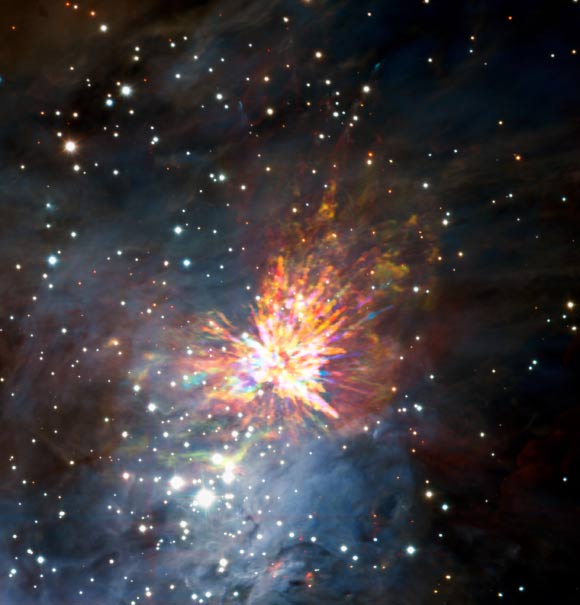Around 500 years ago, two protostars had a perilously close encounter that blasted their stellar nursery apart. The Atacama Large Millimeter/submillimeter Array (ALMA) has now examined the widely scattered debris from this event, gaining new insights into the sometimes-fierce relationship among sibling stars.

Stellar explosions are often associated with supernovae, the powerful and catastrophic deaths of stars. But new ALMA observations of the Orion Nebula complex provide insights into explosions at the other end of the stellar life cycle — star birth. The colors in the ALMA data represent the relative Doppler shifting of the millimeter-wavelength light emitted by carbon monoxide gas. The blue color represents gas approaching at the highest speeds; the red color is from gas moving toward us more slowly. The background image includes optical and near-infrared imaging from both the Gemini South and ESO’s Very Large Telescope. The famous Trapezium Cluster of hot young stars appears towards the bottom of this image. Image credit: ALMA / ESO / NAOJ / NRAO / J. Bally / H. Drass et al.
Stars are born when a cloud of gas hundreds of times more massive than our Sun begins to collapse under its own gravity. In the densest regions, protostars ignite and begin to drift about randomly.
Over time, some stars begin to fall toward a common center of gravity, which is usually dominated by a particularly large protostar — and if the stars have a close encounter before they can escape their stellar nursery, violent interactions can occur.
About 100 000 years ago, several protostars started to form deep within the Orion Molecular Cloud 1 (OMC-1), a dense and active star factory about 1,350 light-years from Earth just behind the Orion Nebula.
Gravity began to pull them together with ever-increasing speed, until 500 years ago two of them finally clashed.
Astronomers are not sure whether they merely grazed each other or collided head-on, but either way it triggered a powerful eruption that launched other nearby protostars and hundreds of colossal streamers of gas and dust out into interstellar space at over 150 km per second. This cataclysmic interaction released as much energy as our Sun emits in 10 million years.
Fast forward 500 years, and a research team led by Prof. John Bally, an astronomer at the University of Colorado, has used ALMA to peer into the heart of OMC-1.
There the astronomers found the flung-out debris from the explosive birth of this clump of massive stars, looking like a cosmic version of fireworks with giant streamers rocketing off in all directions.
“What we see in this once calm stellar nursery is a cosmic version of a 4th of July fireworks display, with giant streamers rocketing off in all directions,” said Prof. Bally, lead author on a paper published in the Astrophysical Journal (arXiv.org preprint).
Such explosions are expected to be relatively short-lived, the remnants like those seen by ALMA lasting only centuries.
“Though fleeting, protostellar explosions may be relatively common. By destroying their parent cloud, as we see in OMC-1, such explosions may also help to regulate the pace of star formation in these giant molecular clouds,” Prof. Bally said.
He and his colleagues observed this feature previously with the Gemini-South telescope in Chile. These earlier images, taken in the near infrared, reveal the remarkable structure of the streamers, which extend nearly a light-year from end to end.
Hints of the explosive nature of this outflow were first uncovered in 2009 with the Submillimeter Array in Hawaii.
The new ALMA data, however, provide much greater clarity, unveiling important details about the distribution and high-velocity motion of the carbon monoxide gas inside the streamers.
This helps astronomers understand the underlying force of the blast and the impact such events could have on star formation across the galaxy.
“People most often associate stellar explosions with ancient stars, like a nova eruption on the surface of a decaying star or the even more spectacular supernova death of an extremely massive star. ALMA has given us new insights into explosions on the other end of the stellar life cycle, star birth,” Prof. Bally said.
_____
John Bally et al. 2017. The ALMA View of the OMC1 Explosion in Orion. ApJ 837, 60; doi: 10.3847/1538-4357/aa5c8b







